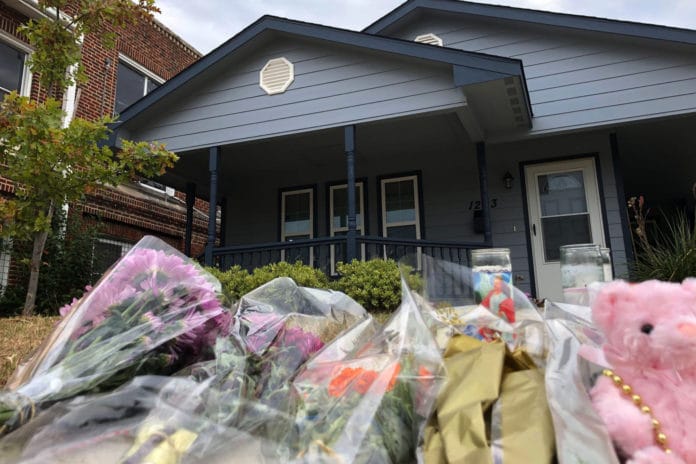FORT WORTH, Texas (AP) — Yashunn Hale isn’t sure he would call the police to report a crime. Not since an officer killed Hale’s neighbor in her home.
Residents of Atatiana Jefferson’s Fort Worth neighborhood said they were hesitant to dial 911 even before a white officer shot the 28-year-old black woman through a bedroom window Saturday. Now, some in the overwhelmingly black and Hispanic area say calling law enforcement is too dangerous.
“It would have to be extreme” to call, said Hale, a 51-year-old black man. “It’s too much 50/50 in the air. It’s not that I’m scared of the police, but you just don’t know who you’re going to catch on the wrong day.”
Jefferson was playing video games with her 8-year-old nephew late at night when she was killed by an officer responding to a call about an open front door. Aaron Dean, 34, did not identify himself as an officer before opening fire and there was no evidence he knocked on the door. He resigned and was charged Monday with murder.
The woman’s death shattered the trust police have been trying to build with communities of color in the Texas city of 900,000, which has long had complaints of racially unequal policing and excessive force.
Jefferson’s slaying was the seventh shooting by a Fort Worth officer this year, and activists have been pushing the department to reform itself for years. At the time of the killing, the city was carrying out recommendations made last December by a task force, including bringing in outside experts to review the police force and hiring a police monitor and a diversity officer.
“It’s like a broken bone,” said Alex Piquero, a criminologist at the University of Texas at Dallas. “The bone needs to be put in a cast so it doesn’t fracture some more.”
Experts warn that such traumatic events can set off a vicious circle: Mistrust of the police leads people to stop reporting crimes and cooperating with officers. That, in turn, makes the police less effective and produces more mistrust.
Piquero said it is important for citizens to remember that most police calls are resolved without incident and that most officers never fire their gun in the line of duty. But the onus is on the department to rebuild trust by showing it is changing its ways, he said.
Interim Police Chief Ed Kraus declared there was “absolutely no excuse” for Jefferson’s killing, and other officers have said people have every right to be mistrustful and mad.
“Saying things like ‘There’s always one bad apple’ doesn’t help right now,” JC Williams wrote in a widely shared Facebook post addressing his fellow Fort Worth officers. “Say ‘I’m sorry’ and because of this I will be better and take responsibility to make others better. This is the first step to some sort of reconciliation.”
Jefferson’s neighbors greeted the murder charges against the officer as a step in the right direction but were furious that police released a photo of a gun Jefferson is believed to have pulled out after hearing suspicious noises behind her house.
And many have little confidence that a legal system they see as distant and unresponsive will hold a white officer accountable for killing a black woman.
“Whatever they’re going to do downtown, they’re going to do it,” said Louis LaFleur, a black 68-year-old who lives a block from Jefferson’s home, referring to the city courthouse. “We could take the whole city and run up there and it still won’t make no difference.”
Jefferson lived in the Hillside Morningside neighborhood, a residential part of south-central Fort Worth, about 30 miles (50 kilometers) west of Dallas, where some 40 percent of people live below the poverty line. The bluish house where she was shot is one of many newly built or renovated homes that have sprung up among the area’s aging but carefully cared for houses and more ramshackle structures.
Hale, a warehouse worker, said he has seen the value of his home rise, and he suggested that the relatively swift charges against Dean and city leaders’ apologetic stance reflect a desire to avoid bad publicity in an area that is rejuvenating.
At the mosque next door to Jefferson’s house, Imam Talib Salahuddin recalled the young woman as having a “nice smile” and “wonderful spirit.” He said that police have been working to improve their relationship with people in the neighborhood, but that there is still a certain distance between them.
Squad cars regularly cruise through on patrol, he said, but officers are rarely seen walking the beat.
Fort Worth is about 40% white, 35% Hispanic and 19% black. Its roughly 1,600-officer police department is 65% white, 21% Hispanic and 10% black.
In a study published in March, the National League of Cities found that black Fort Worth residents were disproportionately assessed fines and fees, and that blacks and Hispanics were more likely than whites to be arrested.
Since the state started collecting data in September 2015, Fort Worth has had more police shootings than smaller cities, but fewer than larger ones. Fort Worth is the fifth-largest city in Texas. The police departments in the top four, Houston, San Antonio, Dallas and Austin, have all shot more people during that time.
Jefferson’s neighbors mostly said they do not believe Jefferson was shot because she was black. But they said the officer would have acted differently in a more white or affluent community.
“If you’re scared of us,” Hale said, “maybe you shouldn’t be working in this neighborhood.”
___
Associated Press writer Nomaan Merchant in Houston contributed to this report.
___
Follow Jake Bleiberg at www.twitter.com/jzbleiberg






